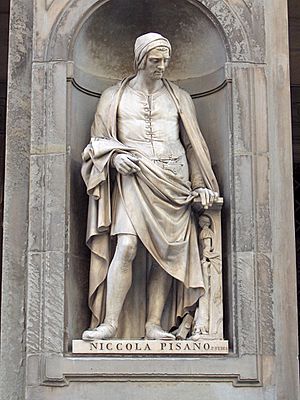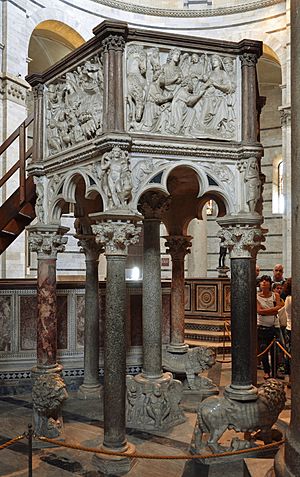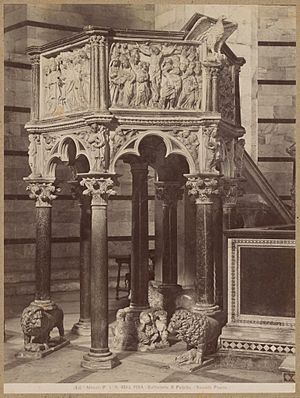Nicola Pisano facts for kids
Nicola Pisano (born around 1220/1225 – died around 1284) was a famous Italian sculptor. He is known for his art style, which looked a lot like the sculptures from Ancient Rome. Some people even call Pisano the founder of modern sculpture!
Contents
Early Life and Art
We don't know exactly when or where Nicola Pisano was born. He came from a place called Apulia in Italy. He probably learned his sculpting skills in workshops run by the emperor Frederick II. Here, he learned to make sculptures that showed more movement and feelings. He mixed old Roman styles with Christian art.
Around 1245, he moved to Tuscany. He worked on the Prato Castle, and the lion statues there might be his work. He also made a sculpture called "The head of a young girl" from a hard stone found on the island of Elba. This sculpture is now in a museum in Rome.
Later, he moved to Lucca. He worked on the front of the Cathedral of Saint Martin. Here, he created a relief (a sculpture that sticks out from a flat surface) called Deposition from the Cross. He also made reliefs for the doorway showing the Nativity (Jesus' birth) and the Adoration of the Magi (the wise men visiting Jesus).
The Pulpit in Pisa
Nicola Pisano moved to Pisa between 1245 and 1250. His son, Giovanni Pisano, who also became a famous sculptor, was born there. Around 1255, Nicola got a big job: to create a pulpit for the baptistery (a building used for baptisms) in Pisa. He finished this amazing work in 1260 and signed it "Nicola Pisanus." He had help from assistants like Arnolfo di Cambio.
This pulpit is one of his most famous works. Nicola Pisano managed to combine the French Gothic style with the classical style of ancient Rome. He likely learned this in Southern Italy. He also studied old Roman sarcophagi (stone coffins) that were in the Camposanto (a historic cemetery) in Pisa. The famous artist Giorgio Vasari said that Nicola Pisano studied these Roman artworks all the time.
The pulpit stands on seven columns. One central column is supported by sculptures of animals and strong figures called telamons. Six other columns surround it. Three of these rest on realistic lion sculptures. The columns themselves came from old Roman ruins.
The columns have fancy tops called Corinthian capitals. These support arches with three lobes, typical of Gothic style. Between the arches are sculptures of St. John the Baptist, St. Michael, and four Virtues (Charity, Fortitude, Temperance, and Prudence).
The pulpit itself has five reliefs made from white Carrara marble. These reliefs show scenes from the Life of Christ:
- The first relief combines three scenes: the Annunciation (when an angel tells Mary she will have Jesus), the Nativity (Jesus' birth), and the Annunciation to the Shepherds.
- The next reliefs show the Adoration of the Magi, the Presentation in the Temple, the Crucifixion, and the Last Judgment.
The backgrounds of these scenes were once painted and had enamel details. This made the religious scenes look even more real. Many of these reliefs show Pisano's deep knowledge of Roman sarcophagi. The figures wear clothes like those in Roman times. For example, the sleeping Mary in the Nativity scene looks like figures from ancient Etruscan tombs.
The Last Judgement scene might have been inspired by Byzantine ivory carvings. The Crucifixion was sculpted with the same grace as French Gothic art of that time.
Nicola Pisano also worked on the dome of the Pisa baptistery between 1260 and 1264. He made it taller by adding a smaller cone-shaped dome on top of the main one.
Shrine of Saint Dominic
In 1264, Nicola Pisano was asked to work on the Shrine of Saint Dominic in Bologna. He designed it, but he was already busy with another big project. So, his assistants, especially Lapo di Ricevuto, did most of the work. This shrine took almost 500 years to finish, with many famous sculptors adding to it over time, including a young Michelangelo.
Pulpit of Siena Cathedral
In September 1265, Nicola Pisano received his next major job: a marble pulpit for the Siena Cathedral. He worked on this pulpit from late 1265 to November 1268. His son, Giovanni Pisano, and other assistants like Arnolfo di Cambio helped a lot.
This is the oldest artwork still in the Siena Cathedral. Nicola Pisano got this job because of how famous his Pisa pulpit had become. The Siena pulpit is similar to the Pisa one but much larger and more detailed. It is considered his masterpiece. The sculptures on this pulpit tell a story about Salvation and the Last Judgment.
Works in Pistoia and Perugia
In July 1273, Nicola Pisano was asked to make an altar for the cathedral in Pistoia. He worked on it with his son Giovanni.
His last major project was the Great Fountain in Perugia (1277–1278). Nicola Pisano's delicate touch can be seen in the fountain. However, most of the sculpting was done by his son Giovanni Pisano and their assistants. This last work shows that Nicola was also influenced by French Gothic art, with its rich details and storytelling.
Nicola Pisano's Legacy
Nicola Pisano was not just copying old Roman art. He studied ancient sculptures very carefully and then created his own original figures. His works are very important because they paved the way for Italian Renaissance sculpture. Many art historians say the Italian Renaissance in sculpture truly began around 1260, the year Nicola Pisano finished his pulpit in the Pisa baptistery.
However, Nicola Pisano also kept some connections to the Gothic art of his time, especially in the Siena Cathedral pulpit. This might be because his son, Giovanni Pisano, finished that pulpit. Giovanni didn't appreciate ancient art in the same way his father did. Both styles, classical and Gothic, existed side-by-side for many years.
Nicola Pisano helped 13th-century Tuscan sculpture move towards art that included features of Roman art. At the same time, he stayed connected to the Gothic art from Northern Europe. The artist who truly carried on Nicola's classical style was Arnolfo di Cambio (around 1250–1302). However, Arnolfo died early, leaving the way open for Giovanni Pisano, who was already developing his own mix of French Gothic and classical styles.
Giorgio Vasari wrote about Nicola Pisano in his famous book, Lives.
See also
 In Spanish: Nicola Pisano para niños
In Spanish: Nicola Pisano para niños






